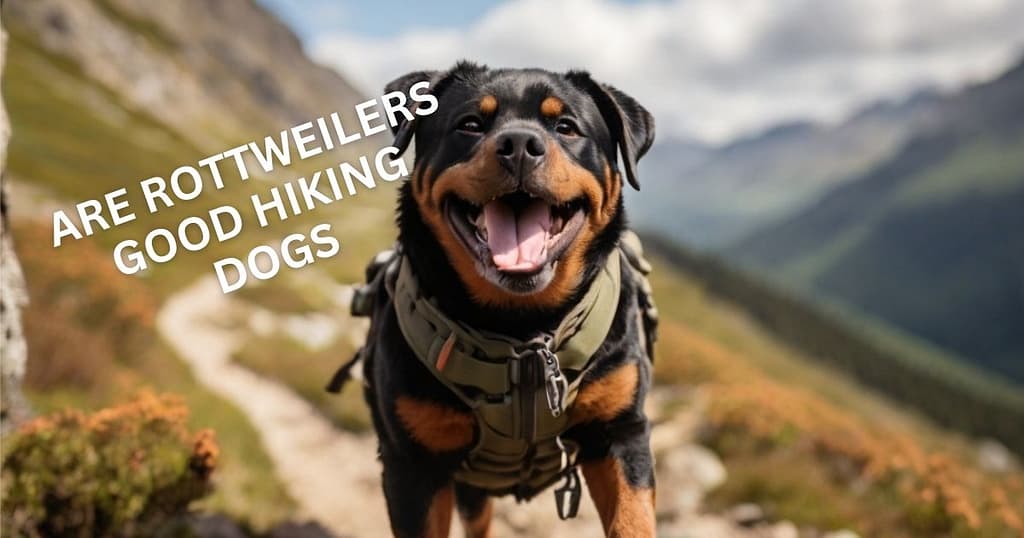You are lacing up your boots, scanning trail maps, and your loyal Rottweiler gazes up with eager eyes. A question flashes: “Are Rottweilers good hiking dogs?” The short answer is yes, absolutely– but with crucial preparation and understanding. As a breed historically bred for endurance and strength, Rottweilers possess remarkable potential as trail companions. Yet, in 2025, with rising summer temperatures and evolving insights into canine fitness, it’s not just about if they can hike, but how to do it right. I have seen Rotties conquer mountain summits and witnessed preventable struggles on simple forest paths. Let’s cut through the myths and uncover what makes these powerful dogs excel (or falter) on the trail.

Understanding the Rottweiler: Built for Work, Not Just Looks
Rottweilers aren’t fluffy couch potatoes – they are engineered for resilience. Knowing their blueprint explains why they can thrive on hikes, but also where risks lurk
From Roman Drovers to Modern Trailblazers: A History of Stamina
Imagine driving cattle across ancient European terrain. That’s the Rottweiler’s origin story. Bred by Roman legions and later German butchers (“Rottweil Metzgerhund”), these dogs guarded livestock over miles of rugged landscape. Their genetics scream endurance
- Muscular Power: A dense, robust frame (80-135 lbs) built for pulling and long-distance travel.
- Mental Fortitude: Bred for focus amid chaos – useful when navigating busy trailheads.
- Loyal Guardianship: An innate protectiveness that translates to vigilance in wild settings.
2025 Insight: Genetic studies (Canine Health Initiative, 2024) confirm Rottweilers retain high percentages of “working dog” DNA markers linked to stamina and pain tolerance compared to companion breeds.
Physical Traits: Strengths and Strain Points on the Trail
Rottweilers are powerhouses, but their build demands mindful hiking:
- ✅ Strength Advantage: Easily handle rocky scrambles, stream crossings, or carrying a light pack (with proper conditioning).
- ⚠️ Joint Vulnerability: Prone to hip/elbow dysplasia. A 2025 OFA report shows 18% of Rotties screened have dysplasia – trail impact matters.
- 🌡️ Heat Sensitivity: That iconic black coat absorbs the sun. Heatstroke risk spikes above 75°F (24°C) – a critical factor as global temps climb.
Real Talk: My friend’s Rottie, Tank, thrives on snowy Colorado trails but struggles on Arizona desert paths. Environment dictates suitability.
The Great Debate: Pros vs. Cons of Hiking with a Rottweiler
Let’s weigh the trail realities – no sugarcoating
Why Rottweilers Can Be FANTASTIC Hiking Partners
- 💪 Unmatched Endurance: Once conditioned, they outlast many breeds. Fit Rotties handle 10-15 mile days on moderate terrain.
- 🛡️ Natural Trail Guardians: Their presence deters wildlife (like coyotes increasingly spotted near urban trails).
- 🧠 Trainability: Highly responsive to commands like “Leave it!” (vital for snakes or trash) or “Wait!” at cliffs.
- ❤️ Bond Deepening: Shared challenges build incredible trust. Veteran hiker Lena Choi (AdventurePaws Blog, 2025) notes: “Hiking with my Rottie, Thor, transformed our communication. He reads the terrain with me now.”
The Challenges You CANNOT Ignore
- 🥵 Overheating Danger: Their #1 risk. Signs include excessive panting, bright red gums, or stumbling. Always hike with cooling gear (more later).
- 🦴 Joint Stress: Steep descents or jumping worsen dysplasia. Stick to graded trails if pre-existing issues exist.
- 🚧 Social Hurdles: Leash reactivity or wariness around strangers/other dogs can escalate on narrow paths. Early socialization is non-negotiable.
- 📏 Size Logistics: Not all trails or shuttles accommodate large dogs. Research access before you go.
2025 Case Study: A tragic incident in Nevada (June 2025) involved a Rottweiler collapsing from heatstroke on a “moderate” trail. The owner hadn’t checked the revised heat index warnings. Check weather apps RELIGIOUSLY.
Training Your Rottweiler for Hiking Success: A 2025 Blueprint
Throwing a harness on an untrained Rottie and hitting the trail is asking for trouble. Here’s how to prepare:
Foundation First: Obedience Isn’t Optional
Master these before tackling technical terrain:
- “Heel” (With Distractions): Crucial near cliffs, wildlife, or mountain bikers.
- “Leave It!” / “Drop It!”: Prevents scavenging toxic plants or dead animals.
- Rock-Solid Recall: If they bolt after a deer, disaster follows. Use long leads (30ft) for practice.
- “Wait” at Obstacles: Teaches caution before stream crossings or downclimbs.
Pro Tip: Train with your backpack on! Dogs associate gear with “work mode.”
Building Trail Stamina: Slow and Steady Wins
Rottweilers aren’t born marathon-ready. Condition like an athlete:
- Start Young (But Carefully): Puppies under 18 months? Stick to short, flat walks. Growth plates are vulnerable.
- The 10% Rule: Increase distance/elevation by no more than 10% weekly.
- Surface Variety: Condition paws on gravel, sand, and rock to toughen them safely.
- Rest Days: Muscles rebuild on rest days. Overdoing it invites injury.
Gear Check: To avoid neck strain, wear a well-fitted harness (not a collar!) Ruffwear’s “Web Master” (2025 model) offers superior support for powerful pullers.
Must-Have Gear for Hiking with Your Rottweiler (2025 Edition)
Forget cute bandanas. This is survival gear:
| Gear | Why It’s Essential | Top 2025 Pick |
|---|---|---|
| Cooling Vest | Cools core temp by 5-7°F. Vital for black coats in sun. | Ruffwear Swamp Cooler™ |
| Collapsible Bowl | Hydrate every 30-45 mins. Rotties need 1.5x more water hiking than at home. | Kurgo Kibble Carrier Bowl |
| Paw Protection | Rock salt, hot sand, sharp scree wreck pads. Booties or wax save trips. | Musher’s Secret Wax (or Ruffwear Grip Trex) |
| Dog First-Aid Kit | Treat cuts, snake bites (carry a compression bandage), or pulled muscles. | Adventure Medical Kits™ Canine |
| GPS Tracker | If they bolt in dense forest, cellular GPS finds them fast. | Fi Series 3 Collar |
Hydration Hack: Add electrolyte supplements (like PetLyte) to water on hot/long hikes to prevent cramping.
Trail Etiquette & Safety: Be the Hiker Everyone Respects
Hiking with a large guardian breed demands extra responsibility:
- Leash Laws = NON-NEGOTIABLE: Even if your Rottie is “friendly,” others don’t know that. Use a 6ft leash. Retractables fail on rocky terrain.
- Yield Proactively: Step off the trail with your dog controlled when others approach – especially horses or nervous hikers.
- Poop Management: Pack it out in biodegradable bags. Never leave bags “for pickup later.”
- Wildlife Wisdom: Keep your Rottie close in bear/cougar country. Their protective instinct might trigger a chase. Carry bear spray within reach.
Expert Insight: “A leashed Rottweiler projecting calm confidence reassures others. An uncontrolled one fuels breed stigma.” – Ranger T. Simmons (National Park Service, 2025).
When Hiking Isn’t Right for Your Rottweiler (And Alternatives)
Not every Rottie is cut out for trails. Skip hiking if your dog has:
- Diagnosed Joint Issues: Opt for swimming or flat, short sniff walks instead.
- Severe Anxiety/Reactivity: Crowded trails will overwhelm them. Try secluded routes at dawn.
- Brachycephalic Traits: Some lines have shorter muzzles – these dogs overheat extremely fast.
- Advanced Age: Senior Rotties (8+ years) often prefer gentle nature walks.
Alternative Adventures: Canicross (trail running together), scent work in parks, or backpacking on dog-friendly campgrounds offer fulfillment with lower risk.
Conclusion: Your Rottweiler Can Be Your Ultimate Trail Buddy – With Wisdom
So, are Rottweilers good hiking dogs? Resoundingly yes – if you respect their physical limits, invest in training and gear, and prioritize safety over ego. They bring unparalleled strength, loyalty, and spirit to the wilderness. But 2025 demands heightened awareness: rising temperatures mean overheating risks are deadlier, and crowded trails require impeccable manners. Start slow, condition meticulously, and always listen to your dog over your ambition. Done right, watching your Rottweiler confidently lead you up a sun-dappled trail, tail wagging with primal joy, is one of life’s greatest adventures. Now lace up, pack extra water, and hit the trail – responsibly
Your Checklist Before Hitting the Trail:
✅ Respect Limits (heat, joints, age).
✅ Gear Up Smartly (cooling vest > cute bandana).
✅ Train Relentlessly (recall > treats).
✅ Hydrate Obsessively (water is non-negotiable).
The wilderness doesn’t compromise—and neither should your preparation. Equip wisely, train patiently, and embrace the journey. Your Rottweiler isn’t just ready for the adventure… they are born for it. Now go earn that view together. 🐾⛰️
See Also: Best Hiking Dog Bowl: Your Pup’s Adventure Companion!
FAQs: Rottweilers as Hiking Dogs
Q: At what age can my Rottweiler puppy start hiking?
A: Avoid strenuous hikes until growth plates close (around 18-24 months). Stick to short, easy walks on soft surfaces until then.
Q: How far can a healthy adult Rottweiler hike?
A: With proper conditioning, 10-15 miles on moderate terrain is achievable. Prioritize rest, hydration, and paw checks over distance.
Q: Are Rottweilers good in cold-weather hiking?
A: Generally yes! Their double coat provides insulation. However, watch for ice buildup between paw pads and limit exposure below 15°F (-9°C).
Q: What’s the biggest mistake owners make when hiking with Rottweilers?
A: Underestimating heat risk and overestimating joint resilience. Pushing too hard on hot days or steep terrain causes preventable emergencies.
Q: Can Rottweilers carry their own gear?
A: Yes! Fit, adult Rotties can carry up to 25% of their body weight in a properly fitted pack (water, collapsible bowl, and their food). Start with empty packs for acclimation.
Q: Do Rottweilers need hiking booties?
A: Not always, but highly recommended on rocky, hot, icy, or salted trails. Use paw wax (Musher’s Secret) as a protective barrier otherwise.



